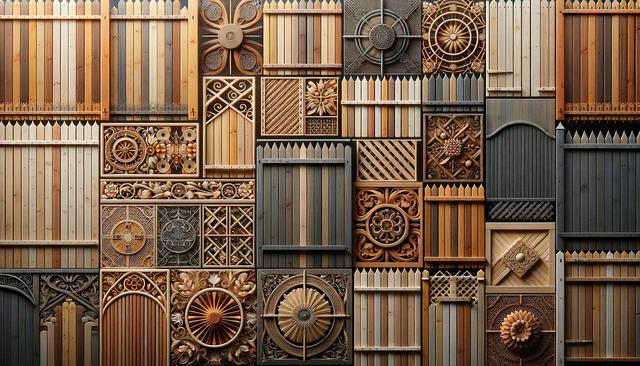
A Closer Look at Wooden Fences: Styles, Prices, Colours, and More
Types of Wooden Fences and Their Uses
Wooden fences come in a variety of styles, each suited for different purposes and aesthetic preferences. Among the most common types are picket, privacy, and post-and-rail fences. Picket fences are decorative and ideal for front yards, offering a traditional look with spaced vertical boards. Privacy fences, on the other hand, use solid panels to block visibility, providing a sense of seclusion for backyards or pool areas. Post-and-rail fences are practical for marking boundaries or enclosing large properties like farms, using horizontal rails between vertical posts for a rustic appearance.
Choosing the right type depends on your specific needs. For example:
- Picket fences work well in suburban settings where aesthetics matter.
- Privacy fences are great for urban homes where close neighbors are common.
- Post-and-rail options suit rural areas or anyone favoring a more open look.
Each style can be further customized with different wood types, heights, and finishes, making wooden fences highly versatile for both function and form.
Pricing: What to Expect
The cost of wooden fences varies widely depending on several factors, including fence style, wood type, height, and labor. On average, homeowners can expect to pay between $15 to $45 per linear foot for installation. Privacy fences generally cost more due to the amount of material required, while picket and post-and-rail styles tend to be more affordable per foot.
Key pricing factors include:
- Wood type: Cedar and redwood are more expensive but offer natural resistance to decay. Pine is more budget-friendly but may require more maintenance.
- Fence height: Taller fences use more material and require stronger support structures.
- Location: Labor costs vary based on region and project complexity.
Additional features like gates, decorative tops, or staining can also add to the overall expense, so it’s important to plan your budget with these elements in mind.
Popular Wood Types and Their Characteristics
The type of wood used for your fence plays a significant role in its durability, look, and long-term maintenance. Common choices include pine, cedar, redwood, and spruce. Pine is widely available and more economical, though it typically requires pressure treatment to resist insects and decay. Cedar offers natural oils that make it resistant to rot and insect damage, making it a popular choice for long-lasting fences.
Here’s a quick comparison of commonly used woods:
- Pine: Affordable and easy to work with, but needs treatment for longevity.
- Cedar: Naturally rot-resistant and visually appealing with a reddish tone.
- Redwood: Premium appearance and durability, often used for high-end projects.
- Spruce: Inexpensive but less durable, suitable for temporary or budget fences.
Each wood type can be painted or stained to suit your aesthetic preferences, though some like cedar and redwood are often left untreated to showcase their natural beauty.
Colour Options and Finishing Techniques
Wooden fences can be left in their natural state or treated with a variety of finishes to achieve the desired look and protect against weathering. Paints and stains come in various colours, from natural wood tones to bold modern shades. Staining is a popular option because it enhances the wood grain while offering protection from moisture and UV rays. Paint provides a more uniform appearance but may peel over time and require more regular upkeep.
Consider these finishing options:
- Clear sealants: Preserve the natural look while guarding against weather.
- Semi-transparent stains: Add subtle colour and highlight wood texture.
- Solid stains or paints: Offer bold colour and maximum coverage.
Regular maintenance is key to keeping your fence looking good. Re-staining or repainting every few years helps sustain its color and integrity, especially in climates with heavy rain or strong sunlight.
Brands and Installation Considerations
While specific brand names aren’t necessary to know, it’s useful to understand what to look for when choosing suppliers or contractors. Reputable fence suppliers often offer warranties on materials and may provide pre-assembled panels for easier installation. When selecting materials, look for wood that is kiln-dried and pressure-treated, as these treatments improve durability and resistance to pests and moisture.
When hiring a contractor or installing the fence yourself, keep these points in mind:
- Check local regulations: Some areas require permits or have height restrictions.
- Mark property lines: Avoid boundary disputes by confirming your lot lines.
- Plan for drainage: Ensure your fence won’t obstruct water flow or collect moisture at the base.
- Post depth: Properly set fence posts in concrete for a stable, long-lasting structure.
Whether you’re opting for a DIY project or hiring professionals, taking time to research and plan will help ensure a successful and attractive installation.
Conclusion: Choosing the Right Wooden Fence for Your Needs
Wooden fences offer a classic solution for enhancing property boundaries, privacy, and curb appeal. With numerous styles, wood types, and finishes to choose from, there’s a wooden fence to suit nearly every need and aesthetic. Taking time to understand pricing, maintenance requirements, and installation factors will help you make a more informed decision. Whether you’re aiming for a charming picket design or a solid privacy barrier, wooden fencing provides both functionality and style when thoughtfully selected and maintained.


